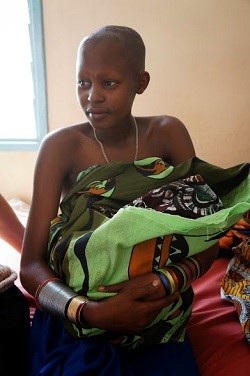International Day of the Girl Child: Using Improvement to Respond to the Needs of Vulnerable Girls
By Elizabeth Romanoff Silva on October 9, 2014

October 11th marks the International Day of the Girl Child, an internationally recognized day designated by the United Nations to promote the rights of girls and to bring awareness to the unique challenges they face around the world. Globally, girls encounter many constraints that limit their ability to access education, to live a life free from violence, to delay marriage and pregnancy until adulthood, and to be involved in making important decisions that affect their lives.
Globally, approximately one third of girls are married before they turn 18. Girls who marry before adulthood are more likely to be taken out of school, experience violence, and become pregnant before they reach adulthood. Early marriage also puts them at greater risk of HIV.
Education: While the gap is narrowing, 61% of the 123 million youth who lack basic reading and writing skills are girls and young women. While primary school enrollment rates are increasing globally for girls and boys, girls are still more likely to be out of school than boys in 63 countries among both primary and lower secondary age groups, with the gap widening in secondary school.
Violence: A newly released report on violence against children from UNICEF found that nearly one in three adolescent girls aged 15 to 19 who are married or in formal unions have been the victims of emotional, physical and/or sexual violence by their husbands or partners. Another form of violence, female genital mutilation/cutting (FGM/C), currently affects more than 125 million girls and women alive today in the 29 countries, mainly in Africa and the Middle East where FGM is most prominent.
Pregnancy More than 15 million of the 135 million live births worldwide are among girls aged 15-19, and complications from pregnancy and childbirth are one of the leading causes of death among girls aged 15–19 in low- and middle-income countries.
HIV/AIDS: In Eastern and Southern Africa, adolescent girls and young women ages 15-25 are more than twice as likely to be HIV-positive as boys and young men, and in certain countries, the disparity is even greater. Girls whose husbands and partners are at least five years older are at greater risk. In Swaziland and Lesotho, the HIV prevalence among adolescent girls 15–17 is more than four times higher than among male adolescents.
But there are many solutions to the problems facing girls. Fulfilling girls’ rights as a child, including their right to education, health, and protection from violence and abuse means girls have the chance to reach their full potential and become empowered women who can support and care for their families and be leaders in their communities and countries.
Through the USAID ASSIST Project, we use an improvement approach to identify and respond to gender-related inequalities and gaps affecting outcomes. In our Vulnerable Children and Families (VCF) programs, we systematically identify and respond to the specific needs of vulnerable girls and vulnerable boys. The USAID ASSIST Project works in Haiti, Kenya, Malawi, Mozambique, Tanzania, and Uganda to improve services for vulnerable girls and vulnerable boys.
Each program uses the science of improvement to identify and respond to the specific needs of girls and boys. In Kenya, where primary school enrollment and retention rates are lower for girls than boys, our team supported local communities to create a girls’ mentorship program and educate students, parents, teachers, community members and provincial administrators on the rights and needs of children, including the importance of educating girls.
This led to an increase in reintegration rates among girls, including girls who had specifically been taken out of school to be married. The team also identified the lack of sanitary pads as a contributing factor to school dropout rates and worked with implementing partners to allocate special funds in three primary schools to purchase sanitary pads for girls. Parents and guardians of vulnerable girls were also sensitized on the importance of providing sanitary pads. Based on these efforts, the team increased the proportion of girls graduating from primary school, as well as boys, and has made progress to close the gap between girls and boys and to improve reintegration rates overall.
It’s important that men and boys be included as part of the solution to empower girls and to champion the cause of gender equality. The lives of girls are greatly influenced by their family and communities, and without bringing fathers on board with the importance of keeping girls in school and delaying marriage until they are adults, a program will rarely have the intended impact. It’s also critical to systematically identify and address the specific needs of vulnerable boys, including their susceptibility to income-generating child labor activities and their increased risk of experiencing physical violence.
On the International Day of the Girl Child, it’s important to realize that while there are numerous issues facing girls around the world, much progress has been made. Through the USAID ASSIST Project, our holistic approach to address the needs of both girls and boys has shown great progress in improving psychosocial support and educational outcomes among girls and boys.